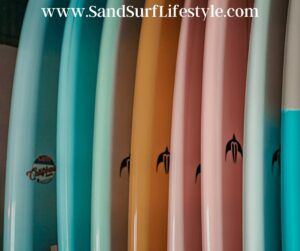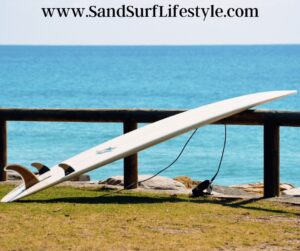Surfboards made of epoxy or fiberglass have come a long way since traditional ones are made of solid wood. Both fiberglass and epoxy surfboards are significantly lighter than their predecessor. This has improved both the maneuverability of the surfboard in the water and the manageability out of the water.
Deciding between an epoxy surfboard and a fiberglass one will be a matter of personal preference. Factors that come into play include the amount of the desired floatation, how well it performs in the water, and the cost of ownership.
Breakdown of the Boards
 Surfboards are made of layers and the materials used to build a surfboard play an essential role in how it performs. Epoxy and fiberglass surfboards may look the same but their differences begin at their very core. In addition, the materials used to build the layers of the surfboard are what make them distinct.
Surfboards are made of layers and the materials used to build a surfboard play an essential role in how it performs. Epoxy and fiberglass surfboards may look the same but their differences begin at their very core. In addition, the materials used to build the layers of the surfboard are what make them distinct.
Epoxy Surfboard Construction:
At the center of most epoxy surfboards, you will find an expanded polystyrene foam core. You’re probably more familiar with the term Styrofoam which is actually a trademarked term for a particular use of EPS foam. Similarly to how you might refer to personal watercraft like a Jet Ski, even if it happens to be a Sea-Doo or a WaveRunner.
EPS foam is great for surfboards because it is lightweight. It’s a rigid foam that can be made into different compressive strengths. This is ideal for a surfboard making it able to hold its form while being stood upon.
What makes EPS foam stand out among other types of foam is its closed-cell structure. This prevents the foam core from absorbing water. It also helps reduce the amount of vapor permanence that can occur.
The next layer of an epoxy surfboard is comprised of several sheets of Hexcel fiberglass cloth and epoxy resin. On top of the epoxy/fiberglass layer comes a layer of a flexible composite. Finally, the surfboard is finished with a coat of high-density gloss paint
Fiberglass Surfboard Construction:
 At the core of a fiberglass surfboard, you are most likely to find polyurethane foam. This type of foam is commonly used in a plethora of industries including furniture, carpet padding, and packing material. You’ve likely seen this familiar egg carton-shaped type of foam being used as a mattress topper or as road case padding.
At the core of a fiberglass surfboard, you are most likely to find polyurethane foam. This type of foam is commonly used in a plethora of industries including furniture, carpet padding, and packing material. You’ve likely seen this familiar egg carton-shaped type of foam being used as a mattress topper or as road case padding.
What makes polyurethane foam different from EPS foam is the cell structure. PU foam is made of open cells that allow in more air. It also makes this type of foam more flexible than the rigid EPS foam.
When it comes to the construction of a fiberglass surfboard, it is the type of fiberglass cloth that is used that makes a world of difference. Each type of fiberglass cloth has properties that provide different results. Most fiberglass surfboards are made from one of these four types:
(1) E fiberglass
(2) S-2 fiberglass
(3) WARP glass
(4) Vola cloth.
E fiberglass:
This commonly used type of fiberglass cloth comes in 4oz and 6oz weights making it the lightest option possible. Boards made of this fiberglass will consist of a minimum of two layers on the deck and one layer on the bottom. Since the 6 oz cloth is stronger than the 4 oz, pros recommend the outer layer on the deck and bottom be the heavier 6 oz cloth.
S-2 fiberglass:
A 4oz S-2 fiberglass cloth is noticeably stronger than E fiberglass. However, due to the higher production costs, this fiberglass cloth is more expensive. This is stiffer fiberglass and is ideal for the deck of the surfboard. It’s a tougher fiberglass cloth that decreases heel dents and dings from collisions.
WARP fiberglass:
Similar to the E fiberglass, this cloth got its name because it contains more fiber strands running the length of the weave. This gives the cloth greater buckle and breaks strength as it flexes and bends. Because there are more warp strands, this fiberglass holds color better which creates bolder designs.
Vola fiberglass:
This cloth is typically seen on longboards. Surfers like this fiberglass cloth for its old-school soda bottle green hue. Vola fiberglass is a heavier cloth but is remarkably flexible and great to use on surfboard fins.
What is a Grom Surfboard? Learn more here.
How They Handle
 Epoxy surfboards are lighter and more buoyant than fiberglass boards making them great for beginners. They’re easier to handle for a better shot at catching and riding the waves. A lighter surfboard means less exertion carrying it to the water. It also reduces the degree of injury from impact during a wipeout.
Epoxy surfboards are lighter and more buoyant than fiberglass boards making them great for beginners. They’re easier to handle for a better shot at catching and riding the waves. A lighter surfboard means less exertion carrying it to the water. It also reduces the degree of injury from impact during a wipeout.
While epoxy boards are lighter, stronger, and faster, most surfers prefer the feel of the ride on a fiberglass surfboard. Epoxy surfboards can feel as if the board is speeding ahead of you and out from under your feet. This is due to the extra buoyancy that keeps it on top of the water giving it more glide.
Another reason why epoxy surfboards are recommended for beginners is their ability to perform well in small to medium-sized waves. They float better making it easier to paddle and more enabled to catch the smaller waves other surfboards miss out on. An epoxy surfboard’s increased buoyancy makes them a good fit for heavy-weight surfers.
How epoxy surfboards compare in performance to fiberglass surfboards is another instance of personal preference. Some people dislike epoxy surfboards for being too stiff and too light. Meanwhile, some surfers may see those aspects of the surfboard as an advantage. To each their own they say.
What They’re Worth
Epoxy surfboards are typically mass-produced due to the high cost of materials and production machinery. Customizations to an epoxy surfboard are costly and will drive up the final price of the specialized board. Since fiberglass surfboards are traditionally hand-shaped, they are more customizable than epoxy surfboards.
On the other hand, epoxy surfboards can take more abuse resulting in fewer dents and dings than a fiberglass surfboard. That’s especially good to know because epoxy surfboards are more difficult to repair in the event it does get damaged. Because epoxy surfboards are more durable than fiberglass boards, they are less prone to getting waterlogged.
A surfboard that becomes waterlogged:
❖ Gets heavier and less buoyant as it absorbs more and more water
❖ Begins to discolor and over time it will start to rot
Fiberglass surfboards are more fragile than epoxy surfboards. This makes them more susceptible to damage during transit, especially when traveling by airplane. For surfers planning to visit the best waves all around the world, investing in the more expensive surfboard will save you money and heartache through its longevity.
Please note: This blog post is for educational purposes only and does not constitute legal or medical advice. Please consult a legal expert or medical professional to address your specific needs.

